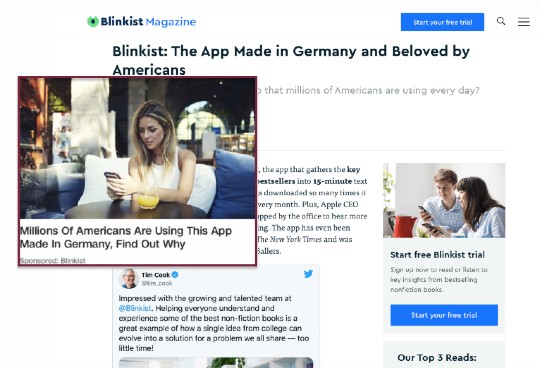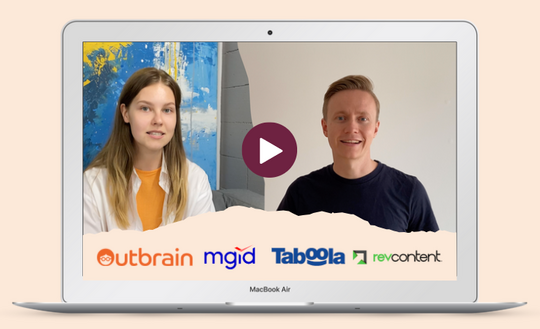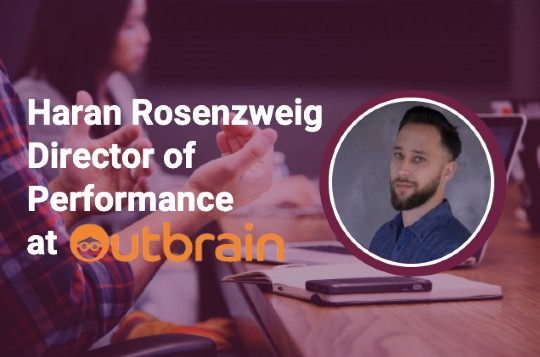
Sandra Wu on Blinkist’s Native Advertising Campaigns
It’s very likely that you’ve already seen native ads run by Blinkist. The company has been running successful native advertising campaigns for a few years and isn’t going to stop.
Blinkist is a book-summarizing subscription service that puts key insights of 3000+ bestselling nonfiction books into pieces that can be read or listened to in just 15 minutes.
To boost their online visibility, nurture audiences, and generate leads, the company leverages the power of content marketing. On their website, you can find interviews with thought leaders, book lists, tips on improving productivity, and more.
But no matter how good your resources are, they won’t drive great results unless you put them in front of your prospective customers. To reach the widest possible audience with their articles, the Blinkist marketing team runs native advertising campaigns as a part of their marketing efforts.
Blinkist’s native ads
In their ad campaigns, they test different combinations of titles, images, and articles. How do they identify the best-performing assets? What goals do they reach? To learn the answers to these and other questions, we talked to Sandra Wu, Paid Content Marketing Lead at Blinkist. She provided us with a few insights into how her team approaches native advertising and shared actionable tips for running better campaigns.
Before we move on to our interview, let’s quickly look at one of the company’s native ads and see what makes it so effective.

This native ad is displayed among others within Outbrain’s content recommendation widget on the CNN website. Instead of showcasing the app interface, Blinkist’s thumbnails usually depict people that might be typical Blinkist users. This example is no exception.
The title arouses interest and entices people to click and learn the answer. Unlike many ads where landing pages don’t meet users’ expectations, this campaign delivers on the promise. The promoted article provides evidence of the popularity of the app in the US, referring to US publications, such as The New York Times, featuring successful Americans’ quotes, and listing the reasons why so many Americans choose Blinkist. This well-researched piece is accompanied by a clear CTA that calls readers to start a free trial of the app.
Is it effective? The case study provided by Taboola says that Blinkist managed to acquire over 60,000 new sign-ups at their goal CPA in just 6 months. Don’t the results speak for themselves?
Now when we’re all a bit jealous, let’s move on to our conversation with Sandra Wu and learn how it was made possible.
How long have you at Blinkist been running native advertising campaigns?
We’ve been running native ads campaigns for 4 years.
What native ad platforms do you use? What should an advertiser consider when selecting the right platform for native advertising?
We only work with Outbrain and Taboola at the moment. Soon you won’t have to choose since they’ll be merging this year! I would always recommend advertisers to have a look at publishers’ portfolios of each platform and see which one has a better product fit.
What are the 3 main challenges of running native ad campaigns?
-
Hands down, coming up with convincing ad ideas is the most difficult task with native ad campaigns. Many would reuse creatives from Facebook or Google, and that isn’t going to work with a broad targeting channel like this. However, it’s also a good way to exercise your creative muscles and think about brand new ways of talking about your product.
-
Convincing your company to let you experiment with this channel for weeks or months before it fully pays off. This is a huge commitment so you need to set the right expectations from the beginning.
-
Understanding where the bottlenecks are. There are lots of steps in the funnel, and it’s important to evaluate each individual one and line up tests to improve each step.
What goals do you set for your campaigns?
At the moment we only optimize towards app installs, but we’re looking to move further down the funnel.
On-Demand Video Course On Native Advertising
Boost your ROAS with native ads. Enroll now with our limited 30% discount.

How often do you test new creatives? How long does it take before you conclude that some ads are effective and some should be excluded?
We test new images and titles once a month, and new articles every week. We can tell within a week if they are successful or not.
How do you select content for your campaigns?
We have an editorial team that produces content just for these channels. We have frequent brainstorming sessions where we invite people throughout the company to come with ideas. Based on what articles have worked in the past, we’ve come up with a scorecard on what a good idea looks like and this is how we decide what to produce.
Blinkist is not the first app you were running native ad campaigns for. Are there any common best practices for promoting mobile apps?
My advice for all apps is to come up with an angle that has a wide appeal that also has a strong connection to your product.
*These words are perfectly illustrated by the above-mentioned campaign example. The campaign content appeals to wide audiences, making people pay attention to it even if they’ve never looked into signing up for a book-summarizing service before.
Has anything changed in your approaches during the lockdown?
We have tried promoting articles specifically tailored for the crisis at the moment (e.g. Expand your horizons with this app) and also just tweaking the titles of old articles.
The latter has proved to be more effective.
How often do you check your performance reports and make decisions about campaigns?
We do this every day.
What common mistakes do advertisers make when running native ad campaigns?
Advertisers may fail to address the challenges I mentioned above and, therefore, they make the following mistakes:
- They try to bring over their knowledge from managing Facebook and Google ads, which are completely different platforms. You need to go into this with an open mind.
- They think they can wrap up a test on this channel in a week or two. In reality, it might take weeks or months before you can be successful.
- They write off failed tests with conclusions like ‘This channel just doesn’t work for us’, instead of figuring out where the bottlenecks are.
If there’s one main takeaway advertisers should keep in mind, what would that be?
Focus on coming up with the best marketing angles and not on tweaking campaigns!
Want to run effective native ad campaigns that reach the goals set but don’t know where to start? We at Joinative can help. Whether you’ve been doing native advertising for some time or have never tried this advertising approach before, we have the right package for you. Apply for our native advertising agency or consultancy services, and start achieving your marketing goals.
Are you running native ad campaigns with Taboola and Outbrain, just like Blinkist? With our native advertising reporting tool, you can boost your campaign performance. Book a free demo today and learn how you can make the most of your native advertising campaigns with Native Pro.

 Feed
Feed


